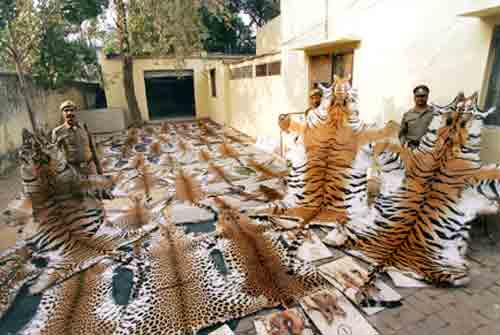Why are they Endangered?
Hunting of Prey — the tiger prey is also hunted by impoverished local people so there is direct competition with man.
Illegal poaching — hunting tigers in Russia was banned in 1947 but with the dissolution of the Soviet Union illegal hunting has been fueled by demand from across the borders in China and Korea. Even though it is illegal to kill a tiger, wild tigers are still being poached today because their bones, whiskers and other body parts can be sold on the black market for a lot of money. Tiger parts are used in traditional Chinese medicine because some people believe that tiger parts have special powers. Forestry and wildlife departments are too understaffed and under budgeted to be effective against the onslaught of poachers. While the exact number of tigers being poached is unknown, some sources have estimated that one tiger a day is being killed in India.

Traditional Chinese Medicine believes that tiger parts will cure disease. However alternatives are available and all ALTA partners are working hard to stop this terrible trade. In the summer of 2007 the world's tiger charities got together to try to work with the Chinese Government so that they take a more effective approach to tiger conservation. What can you do? See our NEWS page for the action you can take. In Russia we still loose up to 30 tigers a year from this terrible trade. We have found that very few tigers die of natural causes - most meet their end at the hand of man. The numbers lost to poachers has reduced over the years even in the face of increased poaching pressure - why? This is due to the effective anti-poaching work carried out by the ALTA partners - some of which is paid for by AMUR.

Loss of habitat to FIRE and LOGGING (both legal and illegal). Whilst areas of habitat are lost to forest clearance, fires and logging there is the added problem that roads built for logging actually increase the human access into remote areas. This causes more disturbance and most importantly gives increased access deep into the forests for tiger poachers.
Across all of Asia, once vast forests have fallen for timber or conversion to agriculture. Only small islands of forest surrounded by a growing and relatively poor human population are left. As forest space is reduced, the number of animals left in the forest is also reduced, and tigers cannot find the prey they need to survive. As a result, tigers begin to eat the livestock of villagers who live near them. Sometimes tigers even attack humans. People sometimes kill the tigers in order to protect themselves and their livestock. As human populations move farther into the forest, groups of tigers become separated from each other by villages and farms. This means that tigers in one area can no longer mate with tigers in nearby areas. Instead, tigers must breed repeatedly with the same small group of animals. Over time, this inbreeding weakens the gene pool, and tigers are born with birth defects and mutations.

